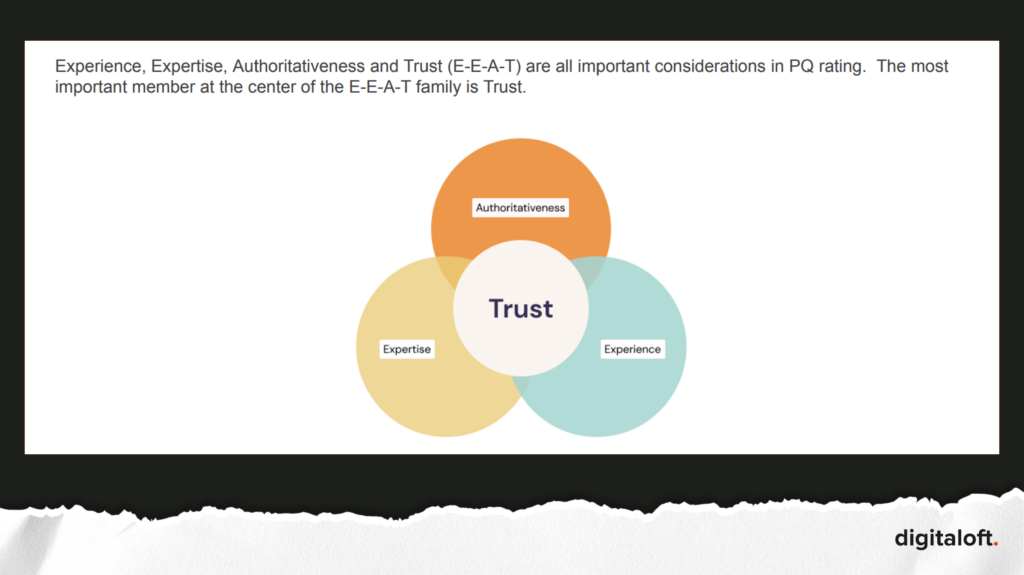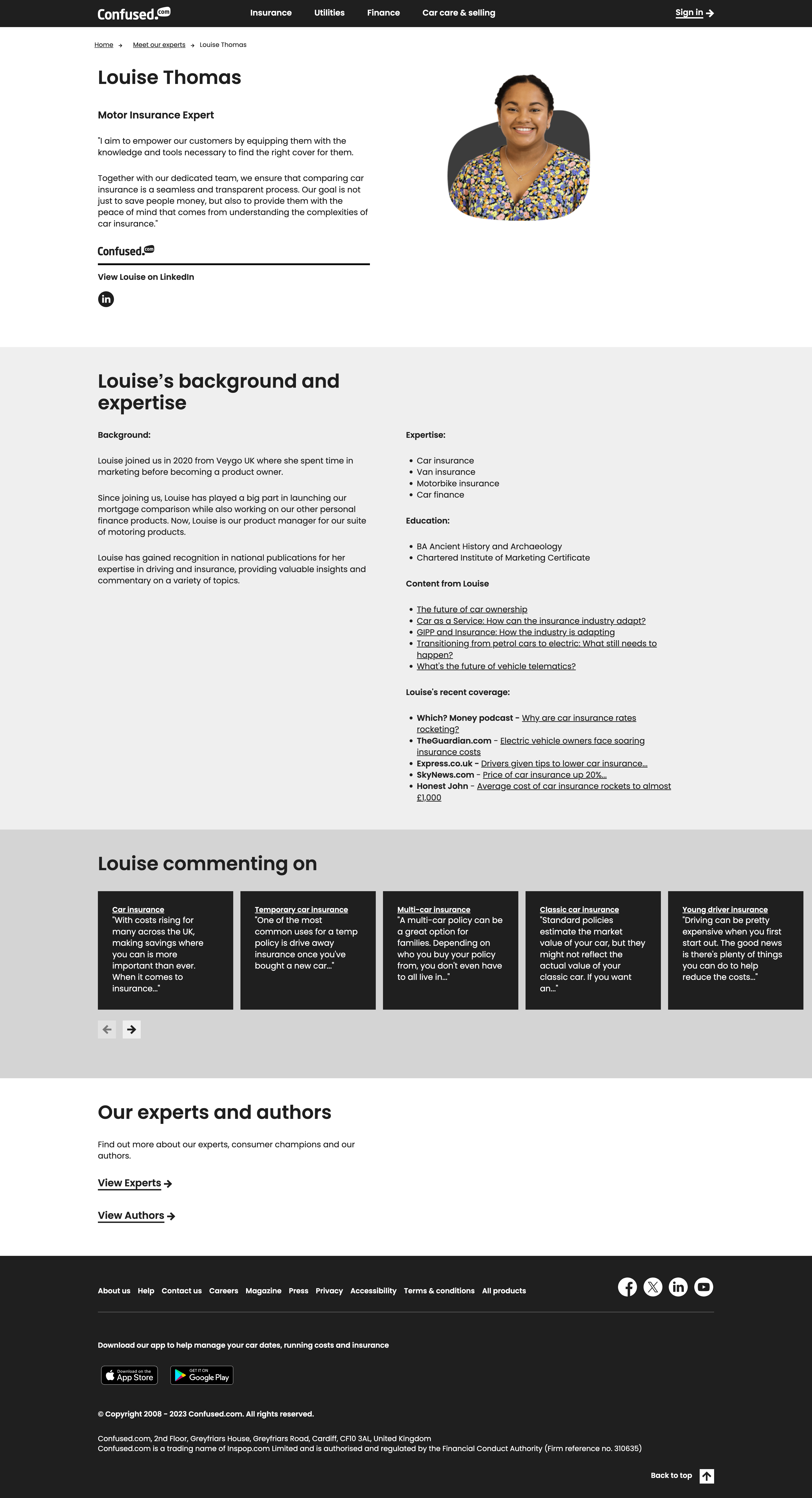
E-E-A-T is a complex topic that many SEOs are still fully getting their heads around, something that’s perhaps not unsurprising, especially given the fact that it’s not a ranking factor but can still have a profound impact on our sites’ organic visibility.
As SEOs, we’ve become accustomed to influencing ranking factors directly impacting search rankings. But that’s not how E-E-A-T works, and it’s something we need to get comfortable with. Just because we don’t see a direct and fast impact, it doesn’t mean it’s not something we should be paying attention to.
In fact, I’m willing to take a guess that those who double down on improving E-E-A-T signals now will be the brands who are comfortably riding each algorithm update without the worry of seeing a negative impact.
Why? Because they’ll have built a solid reputation for their brand and their people, and Google understands this.
You see, E-E-A-T can’t be faked. It’s all about building real signals that highlight your expertise, your authority and your trust, as well as the fact that you’ve got actual first-hand experience in the topics you’re writing about.
And in this guide, I want to encourage you to think about E-E-A-T in a different way than what you’ve probably been doing before.
Keep reading to learn more.
E-E-A-T for Content, Authors & Brands
In the aftermath of September’s Helpful Content Update, one thing that’s become really clear to me is the need to start thinking about E-E-A-T not just as an overall signal or set of signals but at three distinct levels:
- (Main) content level
- Author (creator) level
- Brand (website) level
When looking at many sites that were negatively impacted by the HCU, it’s evident that they lacked E-E-A-T on at least one of these levels.
And when there are other sites demonstrating E-E-A-T at all three levels, these sites win on the SERPs, and those sites that aren’t showing strong signals are seeing themselves negatively impacted, potentially because of the fact that the Helpful Content System has most likely been trained on content that shows these.
But it’s clear that many are still confused about the reasons why their sites were hit in this update.
Tweets like the one below have questioned why ‘big brands’ content is outperforming what’s arguably content that’s more helpful or demonstrates first-hand experience better.
But what is actually happening here is that the sites that saw a negative impact just don’t have the same brand and/or author reputation as those who are outranking them.
And yes, many rightly point out that the content is sometimes more helpful on the smaller sites, but neither the author nor the brand publishing this is as trusted as the bigger sites.
Don’t get me wrong, I’m not saying that these ‘big brands’ should have a free pass to rank content under any topic, but we’ve got to consider why Google continues to reward these so strongly.
It sucks to be hit by any algorithm update, especially if it’s wiped away significant amounts of traffic and revenue that you relied on, but the truth is that in almost all of these situations, there are just not enough signals at every level when compared to those who now outrank the site that show that it offers a better result for searchers.
People want to consume content that’s been produced by people and/or brands they trust. And, of course, that puts smaller sites at a disadvantage, but we must remember that Google’s primary goal is to help searchers find the content that’s the most relevant to their needs. They know that searchers want information fast, which means displaying the results most likely to provide this at the top of the SERPs.
This also means returning results that searchers trust, based on what we know from Google’s Quality Rater Guidelines.

That said, we don’t need to go looking too far to find many examples of sites that aren’t big media publishers ranking in the top spots. Especially when we move away from the terms that have become increasingly targeted by niche and affiliate sites (e.g. ‘Best X…’).
But one thing that’s become very clear is that Google still wants to reward brands. And can you blame them? Brands, by default, are usually trusted by the public. The mere fact that they’ve become so established backs this up.
And whilst most businesses won’t ever become a brand overnight, there’s nothing stopping you from establishing yourself as a key player in your industry. There’s a big difference between becoming a household name and becoming a name in your industry.
This Tweet opens up a real talking point because it’s a great way to highlight the E-E-A-T gap, the difference in signals between those who rank and those who believe they deserve to rank.
And really, the takeaway message here is that just having the best content isn’t enough anymore. You also need to be trusted and seen as authoritative as a brand and as authors.
It almost doesn’t matter how good your content is if there’s no evidence to back up your brand’s and authors’ reputation.
To drive SEO success right now, you’ve got to make sure you’re demonstrating E-E-A-T at all three levels.
Yes, it’s hard work.
Yes, it takes time for Google to connect the dots and fully understand who is behind a webpage and its reputation, but it’s worth it. In fact, we could even argue that it’s become necessary for any business to double down on.
In this guide, I’m going to break down the different levels of E-E-A-T, what these mean and why your site could (probably) be doing more to demonstrate stronger signals in at least one of these.
The Three Levels of E-E-A-T.
E-E-A-T isn’t a single set of signals; it’s a series of both on-page and off-page signals at the content, author and brand levels.
This is something we can infer straight from page 27 of Google’s Quality Rater Guidelines.

Effectively demonstrating E-E-A-T is all about corroborating what a site says about itself (on-site) with third-party evidence (off-site), but you can’t demonstrate these signals at just one level and expect to rank as well as those who demonstrate them at all three.
And once you get into the mindset that E-E-A-T must be demonstrated in every piece of content you publish, for every author who writes for your site and for your brand as a whole, you’ll think about what it takes to do this in a very different way.
It’s about creating content that people trust. To do this, you must understand what makes people trust one piece of content more than another.
I’ll say it once again, E-E-A-T is complex, and what it takes to demonstrate these signals in one industry can be noticeably different to another, especially in YMYL niches.
Where Most E-E-A-T Advice Falls Short.
Too much E-E-A-T advice, in my opinion, fails to break down these signals into three levels. And this means that what it takes to demonstrate signals at each of these becomes too simplified.
At the most basic level, E-E-A-T is assumed to be about ‘authorship’. But it’s about so much more. Yes, part of E-E-A-T is about helping Google to understand who (as an entity) created the content and their reputation, but this understanding fails to acknowledge the brand reputation and a lot of the content-level E-E-A-T signals.
Despite what some people believe, E-E-A-T isn’t just about assigning an author to your content, writing an author bio and sharing key details and ticking this box, just as Danny Sullivan confirmed recently:
Other advice on E-E-A-T, especially following the latest Helpful Content Update, isolates out the content-level signals, leading to the understanding that it’s possible to demonstrate this through having the best content.
It’s not. At least, ranking at the top of the SERPs is not just about having this. It helps, sure, but on its own, it’s not enough.
And to illustrate this, I want to share a few hypothetical scenarios.
Site 1:
- The site demonstrates very high E-E-A-T at the content level.
- The site demonstrates very high E-E-A-T at the author level.
- The site demonstrates low E-E-A-T & demonstrations of an untrustworthy business at the brand level.
Site 2:
- The site demonstrates very high E-E-A-T at the content level.
- The site demonstrates no E-E-A-T (yet) at the author level.
- The site demonstrates very high E-E-A-T at the brand level.
Which of these two site’s content would you trust the most?
I’m guessing it would be site 2, based on the fact that site 1 is deemed untrustworthy, despite the content and author displaying strong E-E-A-T signals. Whilst site 2’s author has no E-E-A-T, let’s assume this is because they’re a new author.
If we then dropped in a third site:
Site 3:
- The site demonstrates very high E-E-A-T at the content level.
- The site demonstrates very high E-E-A-T at the author level.
- The site demonstrates very high E-E-A-T at the brand level.
There’s now going to be no question which site’s content you’d trust the most, given that site 3 displays very high E-E-A-T at all three levels.
This is, of course, a simplified look at the importance E-E-A-T at each level, but makes it clear how there’s a distinct need to focus on building strong signals for your content, your authors and your brand.
The truth is that most advice on demonstrating E-E-A-T focuses largely on how you can demonstrate each of the 4 components of this; Experience, Expertise, Authoritativeness and Trustworthiness, but not how these sit at the three different levels, as well as breaking these down into on-page and off-page tactics.
Demonstrating E-E-A-T for Content.
E-E-A-T at the content level is all about ensuring that the main content on a webpage demonstrates first-hand experience and/or expertise, is considered to be an authoritative source of information and is trustworthy.
The fundamentals of this are making sure that your content adds value beyond what’s already ranking on the SERPs, that it’s written and published by a subject matter expert and that it contains verifiable statements and, particularly in YMYL niches, matches consensus.
Some practical ways to demonstrate E-E-A-T at the content level include:
- Content authored by subject matter experts (not published under ‘admin’ or your marketing person – ideally)
- Clickable link of the author’s name going to a detailed author bio page
- WebPage Schema markup in place that references the author and links to their author profile
- Published and/or last updated date is clearly shown on the page
- Anyone who reviewed the content clearly named, with their name linking to an author bio page
- Content uses unique photos, videos, screenshots or other media to demonstrate first-hand experience
- Content adds value beyond what already ranks on the SERPs, and isn’t just a rehash of existing content
- Content matches the intent of the searcher for key target queries
- Main content links out to sources to back up and verify claims and statements
- The main content includes quotes, comments or unique insights from the author and/or other subject matter experts
- The page has been linked to from other sites, being cited as a source
- Clear to see that effort has been put in by a human to create the content
This is just an example of the types of signals that you can demonstrate at the content level. It’s by no means a comprehensive list and what I want you to take away is that each niche has its own nuances and demonstrating E-E-A-T is very much about getting in a mindset of shoring these signals at every level.
You need to make sure each webpage on your site is demonstrating sufficient E-E-A-T signals. But consider that not every page type will demonstrate this in the same way.
For example, author profile links and bylines are essential for informational content but aren’t relevant for e-commerce product or category pages.
The key to demonstrating E-E-A-T at the content level is to understand the types of signals that can be used and consider these in the context of the page type. You’ll quickly start to determine what signals should exist on different page types across your site.
Looking at on-page vs off-page E-E-A-T signals at the content level, you should expect this to be weighted heavily towards on-page. Off-page signals such as links to and social shares for individual pieces or content are important factors here, but expect to focus your efforts towards on-page signals at this level.
GUIDE COMING SOON: How to demonstrate E-E-A-T at the content level
Demonstrating E-E-A-T for Authors.
E-E-A-T at the author level is all about building and showcasing the reputation of your authors, corroborating what you say about these individuals (on-site) with third-party evidence of this (off-site).
In simple terms, this means making it easy for both users and search engines to understand who authored a piece of content and why they have the experience and/or expertise for this to deserve to rank.
Think of author-level E-E-A-T as a series of signals that combine to show your authors are subject matter experts. And this can be achieved through demonstrating a number of on-page and off-page signals.
Author-level E-E-A-T also applies for any experts who you are using to review your content, and attributing their involvement to this on the page.
Some practical ways to demonstrate E-E-A-T at the author level include:
- Author pages that include a detailed, up-to-date bio for the author
- Author pages marked up using ‘Person’ Schema
- Person Schema uses ‘name’ to define the author’s name
- Person Schema uses ‘jobTitle’ to define the author’s job title
- Person Schema uses ‘description’ to define the author’s bio
- Person Schema uses ‘knowsAbout’ to define one or more areas of specialist expertise
- Person Schema uses ‘sameAs’ to define the author’s social and other professional profiles
- Person Schema uses ‘image’ to define the author’s profile image
- Person Schema uses ‘worksFor’ to define the author’s employer
- The author profile page includes links to the author’s main social profiles
- The author profile page contain links to other content they’ve created on the site
- The author has published multiple pieces of content within the same wider topic
- The author has been cited as an expert in the press, having their comments used by journalists alongside stories that sit in their topic of expertise (this is one way where digital PR teams can support SEO)
- The author has written for third-party publications within the same wider topic
- The author regularly shares content on their socials on their topic of expertise that receives engagement
- The author has a Personal Knowledge Panel on Google
In fact, ‘Inside Google’s massive 2023 E-E-A-T Knowledge Graph update‘ by Jason Barnard of Kalicube on Search Engine Land revealed that the number of Person entities in Google’s Knowledge Graph increased by more than 20 times between May 2020 and September 2023.
This confirms the importance of author-level E-E-A-T and that Google is doubling down on understanding Person entities more than ever before.
Think about E-E-A-T as connecting the dots.
This is exactly how Google’s Knowledge Graph works, corroborating what you say on your site (typically on an author’s bio page) with third-party evidence.
And whilst you’re not totally in control of third-party evidence around an author’s reputation, even if that author is yourself (remembering there are lots of things you can do to increase your chances of increasing off-page signals), you’re fully in control with the on-page you share about who your authors are and their experience.
One of my favourite examples of a well-structured author profile page that does a fantastic job at highlighting who the author is and why they’re an expert in their space comes from Confused.com.

Add to this Danny Sullivan’s recent Tweet (no, I’m still not used to calling it X, either) where he shared feedback he’d passed to Google engineers following comments made by SEOs and others on the platform:

I’m interpreting that ‘Byline leads to no bio info’ means that having clear author pages is the absolute bare minimum of E-E-A-T at the author level.
At the end of the day, SEOs have been talking about authorship for many years, not to forget 2011 to 2014’s Google Authorship Program and 2005’s ‘Agent Rank‘ Patent, which suggested that, “Content creators could be given reputation scores, which could influence the rankings of pages where their content appears, or which they own, edit, or endorse.”
Google’s Authorship Program ended in 2014, largely as a result of low adoption rates by authors and webmasters.
But we know that this is something that’s been on Google’s agenda for a long time now; to be able to understand who created a piece of content and their reputation.
Going back to the 2005 Agent Rank Patent, it continues, “Tying a page to an author can influence the ranking of that page. If the author has a high reputation, content created by him or her may be considered to be more authoritative than similar content on other pages. If the agent reviewed or edited content instead of authoring it, the score for the content might be ranked differently.”
Given the worldwide registration of this patent, it seems likely that this is being used to some degree in Google’s algorithm.
We are also aware that Google has registered a patent around the ‘Credibility of an author of online content‘ that reveals factors that can be used to verify the reputation of any given author. It also confirms that this can be at topic level, with authors able to have different reputation scores in different topics. Further to this, author reputation scores are independent of the publisher.
We see further inclusions in this patent that align with some of the things Google has confirmed in information released about the Helpful Content System. In particular, the Credibility patent states, “Although well-known commercial writers, such as columnists for major newspapers, often generate some of the best-written content, other rather unknown writers often can do just as well but are never recognized for their work. Using the internet, Such writers can reach a gigantic audience, but they need to get noticed. Also, they need to make sure that other, malicious people, do not pretend to be them, and thus destroy their reputation.”
Further to this, we see, “Anonymity on the internet is easy, and makes for fabulous freedom of contribution (e.g., users have no fear of retribution for making honest comments). But it also makes it easy for any person of questionable background to pass themselves off as knowledgeable and then to amplify their viewpoint disproportionately, while making it difficult for those who are actually knowledgeable to provide proof of identity and credentials to correct fallacious information.”
Other key things we can take away from this patent include:
- The reputation score of the author can be further based on how many other online content items of the author have been published.
- Where the author has published other online content items, the reputation score of the author can be further based on how recently the other online content items published.
- If a reputation score is associated with one or more reviewers, then the reputation score of the author can be based, at least in part, on the reputation score associated with the one or more reviewers.
- The reputation score can be portable from one online publisher to another.
- The reputation score can be reduced if the author is determined to have included plagiarized content within the online content item.
- An identity of the author can be authenticated prior to generating a reputation score of the author.
- Determining an authentication score can include receiving a name and personal information from the contributor and determining from a third-party source whether the name and the personal information are associated.
- Determining the credibility factor can include determining information about the author, and verifying the information about the author to be true.
- The verified information about the author can be information as to the author’s membership in an organization. The credibility factor can be further based on information about the organization.
- The verified information about the author can include the author’s employment for an employer. The credibility factor can be further based on the relevancy of the author’s employment to the author’s online content item.
- The verified information about the author can include information about the author’s level of education or training in a field. The credibility factor can be further based on the relevancy of the field of the author’s education or training to the author’s online content item.
- The verified information about the author can include the number of citations to the author’s online content item that are made in other publications of one or more different authors.
There’s a lot to take in here, and a lot to consider.
And whilst we have no formal confirmation that either the Agent Rank or the ‘Credibility of an author of online content’ patents form part of Google’s algorithms today, this is, at the very least, fantastic insight into how Google understands the reputation of an author, balancing on-page and off-page factors.
And these aren’t the only Google patents that give some indication as to what demonstrating E-E-A-T really means. Here’s a great guide from a few years ago by Lily Ray and Bill Slawski that I strongly recommend reading: The Mechanics of E-A-T: How Google Patents Can Help Explain How E-A-T Works.
Whether or not these are the systems that Google refers to when they say that E-E-A-T isn’t a ranking factor but that their systems give even more weight to content that aligns with strong E-E-A-T for YMYL niches, as just one example, we can’t be sure. But there’s a lot to suggest that different E-E-A-T signals are used by one or more ranking systems.
To put it simply, the reputation of your authors matters. And in my opinion, it’s this level where many sites that got negatively affected are lacking.
Do more to build and demonstrate the reputation of your authors, and there are very good indications you’ll be rewarded for doing so.
Check out our guide to the role of digital PR in demonstrating E-E-A-T to gain a deeper insight into how this tactic can help to elevate the reputation of your authors (and brand).
Coming back to Google’s expansion of Person entities over the last three years, we can infer from this that establishing your authors as entities in their own right (with confirmation of this coming via a Personal Knowledge Panel) is something that we should all be working towards.
GUIDE COMING SOON: How to demonstrate E-E-A-T at the author level
Demonstrating E-E-A-T for Brands.
E-E-A-T at the brand level is all about building and showcasing the reputation of your brand. In this case, we’re referring to the website that is publishing content as the brand, but also the organisation behind this website.
And in many ways, this is about giving users a reason to trust the business, whether that’s a publisher, an eCommerce store, service business or other type.
We’ve already confirmed the importance of trust in E-E-A-T, but it’s safe to assume that trust is most strongly weighted at the brand level.
Ultimately, users want to discover websites they can trust via search engines, and we know from the Quality Rater Guidelines that untrustworthy pages should be given the lowest rating.

Ultimately, I have a strong suspicion that brand-level E-E-A-T (or a lack of it) was another big factor in those sites negatively affected by the latest Helpful Content Update.
I’ve referred to this update a few times as one that could have been called “the real business update.”
Why?
Because the majority of sites that have been hit are ‘niche sites’ that, in all honesty, have very little trust signals at the brand level. In some cases, there has even been efforts taken to hide who is behind the site.
Yet there’s still little evidence of ‘real businesses’ being negatively affected, even when their content is maybe not quite as good as that on other sites deemed less trustworthy.
Brand signals are a big deal, and that’s been made clearer than ever by the fact that sites like Forbes and CNET can rank for all sorts of terms outside of their key areas of topical authority (but that’s not a debate for now).
Some practical ways to demonstrate E-E-A-T at the brand level include:
- A physical business address visible on the site (not a virtual address or mailbox)
- Easy-to-find contact information; phone number, email address and a contact page etc
- Standard policies and notices you’d expect from a real business
- Privacy policy
- Terms & Conditions
- Cookie policy
- Copyright notice
- Return policy (eCommerce)
- Delivery policy (eCommerce)
- Complaints procedure
- A detailed ‘About Us’ page that gives an insight into the site and who is behind is
- A ‘Meet the Team’ page that links to author/expert bio pages
- Evidence of memberships or accreditations held by the brand
- An ‘In the Press’ page or display of ‘As Featured In’ logos that link to press coverage
- Easy-to-find information on the company information, if not clear who is behind the site
- Brand searches showing on keyword tools (brand searches are an indication people are searching for you specifically)
- Positive customer/client reviews or testimonials displayed on the site
- Positive customer/client reviews or testimonials displayed on third-party sites
- The brand is consistently earning relevant press coverage and links
- A brand search returns positive sentiment results on the SERPs
In many ways, E-E-A-T at the brand level is all about doing the things that help potential customers and clients trust a business, regardless of whether or not those signals are used by Google.
And it’s important to remember that whilst some of these things are site features, a lot of factors at the brand level need to be kept on top of and up to date.
Positive PR coverage, as an example, should be consistent. It’s relatively easy to get featured in the press once, regardless of whether you’re a trusted brand or not. Anyone can get lucky. But continued coverage, that references not just the brand but your authors, too, is a much more difficult task to accomplish, and one that goes a long way to building trust signals and your overall brand reputation.
GUIDE COMING SOON: How to demonstrate E-E-A-T at the brand level
E-E-A-T: Set Your Industry’s Gold Standard
Whilst E-E-A-T absolutely remains an area of uncertainty for many SEOs, especially given continued confirmation from Google that it’s not a ranking factor, we need to change our mindset on it.
If we stop thinking about E-E-A-T in the same way as the more traditional ranking factors we’re used to, where we do X and see Y impact, and instead think about it as doing the necessary things to help people to trust our content, authors and brand, we stop expecting the same verifiable outcome as with other tactics.
Should we be doubling down on E-E-A-T signals as we move into 2024? Absolutely.
And just because you can’t directly attribute impact to this in the same way you can some tactics, that doesn’t mean you should ignore it.
In fact, you should work to set your industry’s gold standard for what E-E-A-T looks like.
Go above and beyond what your competitors are doing, and work to do better at demonstrating experience, expertise, authoritativeness and trustworthiness at each of the content, author and brand levels.
Do the things that help people to trust you, whatever they might be in the context of your business, your people and your content.
No two businesses or websites are the same, which is why there’s never going to be a definitive list of E-E-A-T factors that you must display. Some are relevant to some businesses and not others.
But when you take the time to understand why Google continues to push E-E-A-T, you’ll soon start to think of what it’s going to take to be your industry’s gold standard.



